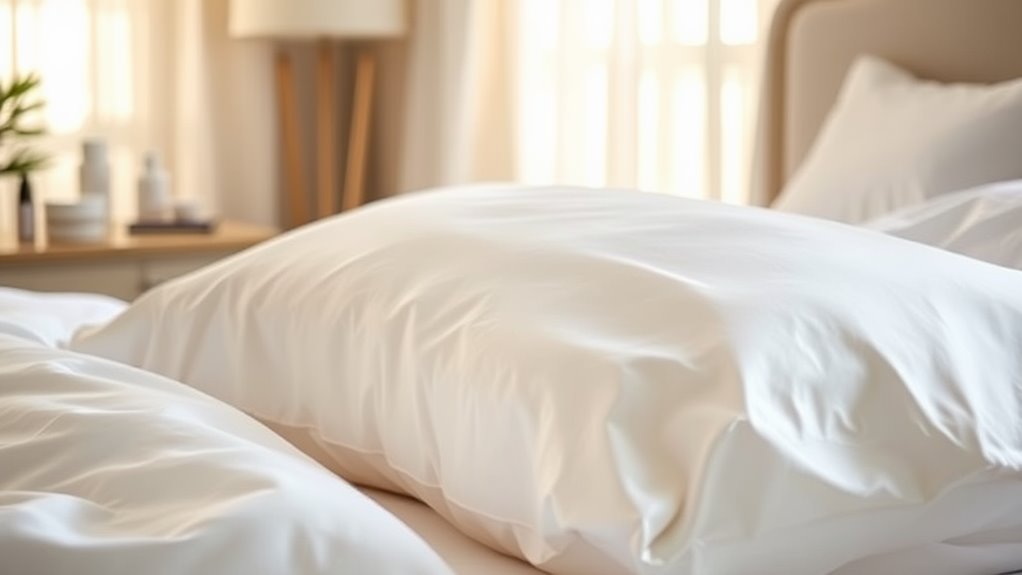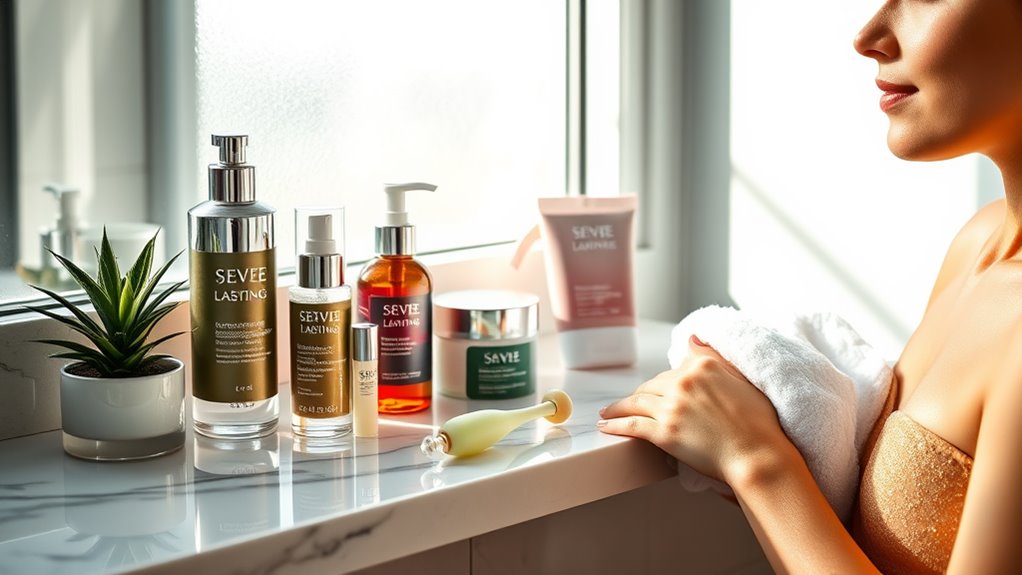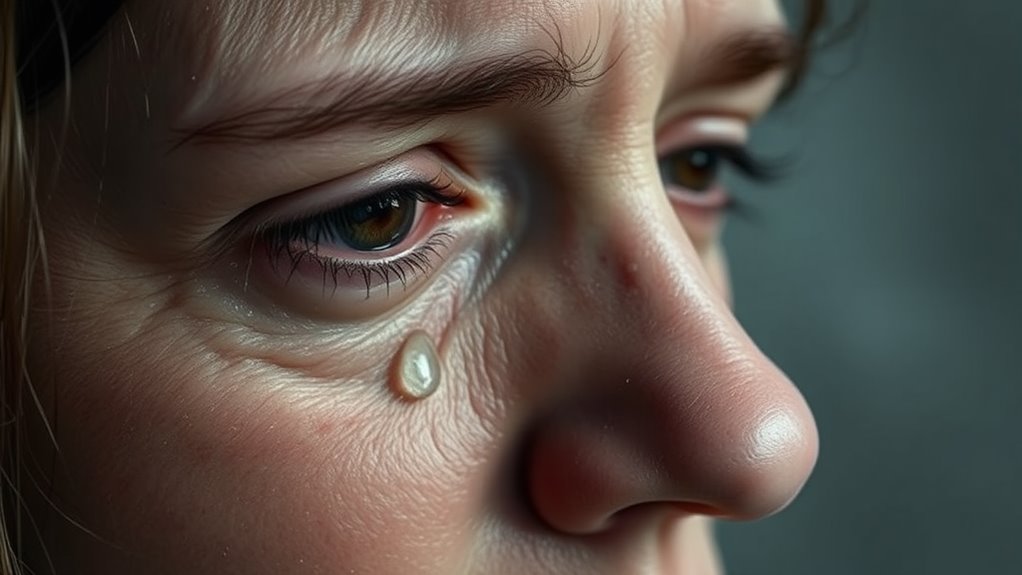Could Your Pillowcase Be Hurting Your Skin. Here’s What to Know
Your pillowcase can definitely hurt your skin. Materials like cotton absorb moisture and oils, which can lead to dryness and irritation. Silk, on the other hand, minimizes friction and maintains hydration. Dirty pillowcases harbor bacteria and allergens, contributing to breakouts. Regular washing is crucial to keep your skin healthy; aim for at least once a week with gentle, hypoallergenic detergents. Discover more about which pillowcase options might suit your skin best and tips for maintenance.
Key Takeaways
- Pillowcase materials like cotton can absorb moisture, leading to dryness and skin irritation.
- Silk reduces friction, promoting a smoother complexion and minimizing irritation.
- Dirty pillowcases harbor bacteria and allergens, contributing to breakouts and skin issues.
- Regular washing of pillowcases is crucial to eliminate oils, dirt, and allergens.
- Choosing hypoallergenic and breathable fabrics can help maintain skin health and prevent irritation.
The Impact of Pillowcase Materials on Skin Health
When you consider your skin care routine, the material of your pillowcase plays a crucial role in maintaining healthy skin. The pillowcase skin effects can be significant, influencing everything from hydration levels to acne flare-ups.
For instance, cotton pillowcases can absorb moisture and natural oils from your skin, potentially leading to dryness and irritation. Conversely, synthetic materials may cause friction, exacerbating skin conditions.
Moreover, the accumulation of bacteria and allergens on your pillowcase can also contribute to skin issues. To master your skin health, choose materials that minimize these negative pillowcase skin effects. Regular cleaning of your pillowcase can help reduce the buildup of irritants and promote healthier skin.
Regularly switching your pillowcase and opting for breathable fabrics can create a more favorable environment for your skin to thrive. Prioritize your pillowcase choice for optimal skin care results.
Cotton vs. Silk: Which Is Better for Your Skin?
When choosing between cotton and silk pillowcases, consider how each material affects your skin’s health. Cotton offers breathability and moisture retention, which can keep your skin hydrated, while silk reduces friction, minimizing irritation and promoting a smoother complexion. Additionally, using materials that are gentle on the skin can help alleviate sensitive skin symptoms, enhancing your overall skincare routine. Understanding these differences can help you make an informed decision for your skincare routine.
Breathability and Moisture Retention
While both cotton and silk have their unique benefits, understanding their breathability and moisture retention properties can significantly impact your skin health.
Cotton is highly breathable, allowing air circulation that helps regulate temperature. However, it tends to absorb moisture, which can lead to dryness and irritation if you sweat or use skincare products overnight.
On the other hand, silk is less absorbent, helping to maintain your skin’s natural moisture levels. Its smooth texture allows for optimal breathability while preventing excess moisture loss.
This balance keeps your skin hydrated and comfortable. If you’re aiming for healthier skin, silk may provide a superior option due to its moisture retention and breathability, ensuring you wake up with a refreshed complexion.
Friction and Skin Health
Friction plays a crucial role in skin health, especially when considering the materials of your pillowcase.
Cotton, while breathable, often creates more friction against your skin, potentially leading to irritation and sleep lines over time. If you’re serious about skin care, switching to silk can be beneficial.
Silk’s smooth texture reduces friction, minimizing irritation and allowing your skin to glide effortlessly against the pillowcase. This can help maintain moisture balance and reduce the likelihood of breakouts.
Additionally, silk contains natural proteins and amino acids that may promote skin health. To optimize your skin’s condition, consider investing in a high-quality silk pillowcase; your skin will thank you for the reduced friction and enhanced comfort during sleep.
The Role of Cleanliness in Skin Irritation
Maintaining cleanliness is crucial for preventing skin irritation, as dirty pillowcases can harbor bacteria, oils, and allergens that exacerbate skin issues.
When you sleep, your skin comes into direct contact with these contaminants, leading to clogged pores and potential breakouts. Regularly washing your pillowcase—ideally once a week—removes these harmful substances and supports your skin’s health. Moreover, sleeping with makeup on can also contribute to clogged pores, making it essential to cleanse your face before bed.
Consider using a gentle, fragrance-free detergent to avoid additional irritation, especially if you have sensitive skin. Additionally, choosing natural fibers like cotton can promote better breathability, reducing moisture retention that can foster bacteria growth.
Allergens and Irritants: Hidden Risks in Your Pillowcase
Your pillowcase can harbor dust mites, which may trigger allergies and worsen skin conditions. Additionally, the fabric material you choose might irritate your skin or cause sensitivities. Bacteria and fungi can also thrive in unwashed pillowcases, posing hidden risks to your skin health. Furthermore, sleeping on dirty hair can introduce bacteria and fungi that exacerbate breakouts and irritation on your skin.
Dust Mites Impact
Although you may not see them, dust mites thrive in your pillowcase, posing significant risks to your skin and overall health.
These microscopic creatures feed on dead skin cells, and their waste products can trigger allergic reactions, leading to redness, irritation, and even acne flare-ups. If you’re prone to skin sensitivities, the presence of dust mites can further exacerbate conditions like eczema or dermatitis.
Regularly washing your pillowcase in hot water can help reduce their population, but it’s essential to also consider encasing your pillows in allergen-proof covers.
Fabric Material Sensitivity
When considering your skin’s health, the fabric of your pillowcase can play a crucial role in either promoting or aggravating sensitivities.
Certain materials can harbor allergens or irritants that might trigger reactions, impacting your complexion. Here are four key factors to evaluate:
-
Cotton: Generally hypoallergenic, but untreated cotton can be a breeding ground for dust mites.
-
Silk: Known for its smooth texture, silk minimizes friction, but some may react to the dyes used.
-
Polyester: Often blended with other fabrics, it can trap heat and moisture, leading to irritation.
-
Bamboo: Eco-friendly, but ensure it’s processed without harsh chemicals that may irritate sensitive skin.
Choosing the right fabric can significantly enhance your skin’s health.
Bacteria and Fungi Growth
Even if you maintain a rigorous cleaning routine, bacteria and fungi can thrive in your pillowcase, posing hidden risks to your skin health.
These microorganisms feed on bodily oils, sweat, and dead skin cells, creating an environment ripe for irritation and breakouts. You mightn’t notice their presence, but over time, they can exacerbate conditions like acne and eczema.
To mitigate these risks, regularly wash your pillowcase in hot water and consider using antimicrobial fabrics that resist bacterial growth.
Additionally, replace your pillowcase weekly to minimize accumulation. By adopting these practices, you can significantly reduce the likelihood of skin issues linked to bacterial and fungal growth, ensuring your sleep environment supports your overall skin health.
How Pillowcases Can Contribute to Acne
Many people overlook the role pillowcases play in skin health, yet these fabric surfaces can harbor bacteria, oils, and dead skin cells that contribute to acne.
When you rest your head each night, you may be introducing these irritants to your skin.
Here’s how pillowcases can exacerbate acne:
-
Bacterial Growth: Bacteria thrive in unclean environments, promoting breakouts.
-
Oil Accumulation: Natural oils from your skin transfer to the pillowcase, clogging pores.
-
Dead Skin Cells: Shedding skin cells can accumulate on fabric, causing irritation.
-
Allergens: Dust mites and other allergens can trigger inflammation and acne flare-ups.
Understanding these factors is essential for maintaining clear skin. Additionally, regularly washing your pillowcase can significantly reduce bacteria and oils that lead to breakouts.
Pay attention to your pillowcase and its impact on your complexion.
The Importance of Regular Washing
Maintaining clean pillowcases is vital for your skin’s health. Over time, oils, sweat, and dirt accumulate on your pillowcase, creating a breeding ground for bacteria and fungi.
When you press your face against these contaminants night after night, you risk exacerbating acne, irritation, and even allergic reactions. Ideally, you should wash your pillowcases at least once a week, using a gentle detergent to eliminate any lingering impurities.
If you’re prone to skin issues, consider washing them more frequently. Additionally, avoid fabric softeners, as they can leave residue that clogs pores.
Moisture Retention: The Case for Silk Pillowcases
Silk pillowcases can be a game changer for your skin’s moisture retention. Unlike cotton, silk helps maintain your skin’s natural hydration levels, reducing dryness and irritation.
Here are four reasons why you should consider switching to silk:
-
Low Absorbency: Silk doesn’t absorb moisture like cotton, keeping your skin hydrated throughout the night.
-
Smooth Surface: The soft texture minimizes friction, reducing the likelihood of skin irritation and wrinkles.
-
Hypoallergenic Properties: Silk resists dust mites and allergens, promoting healthier skin.
-
Temperature Regulation: Silk helps regulate body temperature, preventing overheating and excessive sweating that can affect skin moisture.
Switching to a silk pillowcase not only enhances your beauty sleep but also supports your skin’s hydration, contributing to a radiant complexion.
Choosing the Right Pillowcase for Sensitive Skin
Finding the right pillowcase can significantly impact your skin’s health, especially if you have sensitive skin.
Opt for materials like silk or bamboo, as they’re hypoallergenic and gentle on your skin. Cotton can also be a good choice, but ensure it’s high-quality and breathable to minimize irritation.
Avoid synthetic fabrics that may trap moisture and exacerbate skin issues. Look for pillowcases that are free from dyes and chemicals, as these can trigger allergies or sensitivities.
Additionally, consider the weave; a tighter weave can reduce friction, preventing irritation.
Finally, prioritize regular washing to eliminate allergens and bacteria.
Tips for Maintaining a Skin-Friendly Pillowcase
While you may have chosen the perfect pillowcase for your sensitive skin, it’s essential to keep it clean and fresh to reap its full benefits.
Here are some tips to maintain a skin-friendly pillowcase:
-
Wash Regularly: Aim to wash your pillowcase at least once a week to remove oils, dirt, and allergens.
-
Use Gentle Detergents****: Opt for hypoallergenic, fragrance-free detergents to minimize irritation.
-
Choose the Right Temperature****: Wash in warm water to effectively eliminate bacteria while protecting fabric integrity.
-
Avoid Fabric Softeners: These can leave residues that irritate sensitive skin; stick to natural alternatives instead.




